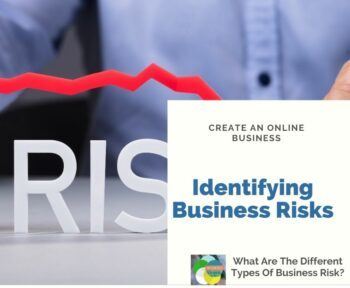There is not a business today operating without risk. Everything they do comes with risk, some of which could cause devastating consequences. Some larger companies and corporations may be able to handle risks, only feeling a small bump. That is not the case for smaller businesses, where any little risk could send them out of business. For this reason, knowing risks that could cause harm is crucial. It saves companies from harm and potential damages that could result from investments and/or other business activities. In this article explains how business risks affect to the business and how it can be identified.

Knowing which risks come with operations and investments along the way, companies can protect themselves. The process of identification is done by a selected team of critical thinkers or, sent off to a third-party company.
An in-depth analysis of potential risks a company poses provides insight. This insight helps keep companies away from harm and guide them in making better business decisions. When starting a risk analysis, identification of potential risks is the first step. After spotting them, businesses can think about ways to tackle them in case they come up.
Identifying Business Risk
Identifying business risks, companies can better prepare. The areas where businesses are vulnerable revealed during the process of identification offer insight. It shows exactly what areas are vulnerable, giving companies time to construct a plan or strategy.
The best way to act is proactive, identifying the risk, and stopping it before it is too late. To identify potential business risk, companies can follow three simple steps:
1. Brainstorm
First, companies need to get their thinking caps turned on and ready to work. It is best to think of potential risks, digging in deep to all branches of the company. During this process, it is best to make a list of noted vulnerabilities. Using this list, it is easier to identify where to begin and which risks pose the biggest threat.
2. Analyze
After a solid list is made, it is time to think about how to tackle each problem. Looking into resources available is one way to begin. Companies should know their resources available.
From there, they can identify where they fall short. Securing proper resources, companies can rest assured knowing their risks and how to protect themselves. During analysis, companies should rank risks based on likelihood and impact. The higher the impact the more important.
3. Act
Once potential problems and solutions are identified, it’s time to act. The best way to nip risk in the bud is to prevent things before they happen. Acting too late could cause companies weeks, months, or even years of damage. Acting fast and taking preventative measures toward future damage is key. A helpful way to start and keep protected is risk management.
What is Risk Management?
Risk management is a powerful tool to use to keep businesses away from business risk. It is essentially an attempt to prevent future mishaps, using in-depth analysis. While we cannot predict the future, identifying potential risks is the best way to protect companies from harm.

Once things that could harm a business come into sight, owners have a chance to act proactively. Making good and healthy business decisions based on findings leads to success and eliminates business risk.
While the risk management process is not a complicated one, it is an ongoing one. Strategies that companies adopt must remain unless the potential for risk disappears. Regular analysis and reviews of a company’s function and performance are a part of the process.
Keeping up with potential harms, companies can adjust their process and better execute the best risk management strategy for them.
Top Risk Management Strategies
Once a business risk arrives, it’s time to tackle it. The chosen strategy should be one that suits the company and keeps them afloat. Using the ranking discovered during analysis, those in charge can decide how to handle each risk.
It is impossible to keep all things from happening, the potential is always there. A bit of planning and analysis goes a long way. This can bring about solutions in the case that any of these risks show up. Useful strategies companies can use based on raking include:
Avoid it
They say you have to spend money to make money. Riskier investments generally come with higher profits, making them very attractive. While this is true, not every investment turns out the same. There is always some sort of risk attached, especially when navigating through uncharted waters.
The higher the impact scores among a list of potential risks, the fewer companies will want to deal with it. Avoiding the noted risk is perhaps one of the most drastic strategies, meaning that the initial idea is trashed. If business risk is too high, this is the best strategy.
Reduce it
If avoiding the activity is not an option, then companies can work on minimizing the effects. Risk mitigation takes the potential risk and deploys solutions that will minimize the effects. It is also a strategy used to find ways to stop the risk from appearing altogether.
Reducing risk is one of the most commonly employed strategies, allowing businesses to walk the line while remaining protected. Avoiding the activity that brings risk is the safest option but, a reduction is not far off.
Transfer it
Once a risk management framework takes place, some risks may come with an impact too large. That’s when a transfer is the best option, using a third-party to take some of the weight off. The most common party to share risks are insurance companies. After an in-depth risk assessment, insurance companies will draw up a policy.
This policy is meant to provide protection in all of the areas of risk. An iron-clad insurance policy is great however, they don’t come cheap. Insurance is a great option and is a great way to tackle risk but, the cost could pose a problem.
Accept it

Not all risk management strategies come for free. Avoiding the risk could bring business to a halt, slowing down productivity and decreasing overall success. Reduction and transfer could add up, taking the creation of systems or processes that could be time-consuming and costly.
Acceptance is one option that allows businesses to make riskier decisions without any cost. While this may sound great, acceptance is also the riskiest.
What Comes Next?
Risks never disappear completely. Their assessment and analysis both need monitoring to keep businesses safe. Businesses need to keep operational risk management as part of their operations.
This cyclic process keeps a close watch on activities, giving a closer look into how business is affected by investments and future endeavors. Just because a strategy is working at first, does not mean that it will maintain the same force. Keeping track of how strategies play out is a sure way to stay ahead of potential problems.
Preventative measures are the most powerful force to use against business risk. These preventions however don’t just appear, taking some critical thinking to reveal them. The risk for business is never zero, and most times, companies will have to choose the lesser of two evils.
Instead of going at it alone, companies have the option to partake in a risk assessment. During this assessment, professionals will point out risks, allowing companies to then decide to act as they see fit.









